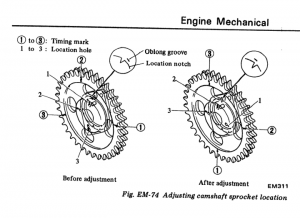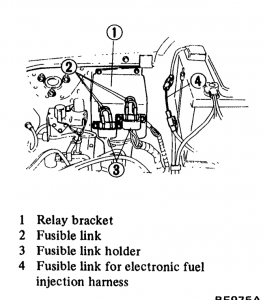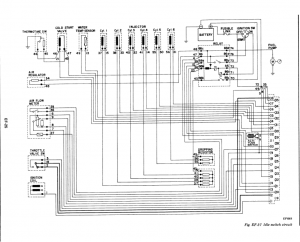Everything posted by Zed Head
-
77 Z Drives For About 10 To 15 Minutes,then Dies.
I was thinking more of dirty connections, not a melted link. I mentioned early on in this thread about someone with a fuse, hidden in the trunk, that would open the connection when it got hot, then close and mysteriously fix itself when it cooled. It's apparently a BMW problem that has happened to more than one person, but is not common. The fuse is in a moist spot and after 25+ years the corrosion builds up. He might fix the problem with just a wiggle of those connections.
- 77 Z Drives For About 10 To 15 Minutes,then Dies.
-
77 Z Drives For About 10 To 15 Minutes,then Dies.
I'm still back on "engine dies tach goes to zero". You're right though, I did not delve in to the details, I'm just posting things that might help. Plus, I can't really figure out how exactly that combined relay works. Is there not a diode between Pins 36 and 39? It connects the two relays somehow, but what does it do? No offense to crazy but the wiring diagram and the information you posted are in the same chapter as the tests he's run. The trees and forest thing. Maybe the fusible link you mentioned is the one overheating. Check 'em all.
-
L28 Rebuild? Swap? Leave Alone?
Your chain guides actually look in really good shape. The used ones I've seen all have grooves worn in them from the links rubbing. The damper pulley looks like a problem. I don't know if Nissan put zero at the same spot on both styles or started from scratch with each design. I think that you could get a 240Z pointer and be right, assuming the damper is in good shape. But it's always good to confirm the TDC mark is correct.
-
Timing Chain Rotation To Hole #3
I think I had my befores and afters backward in my other comment. Looks like you're at after-after now so should accomplish your objective well.
- 77 Z Drives For About 10 To 15 Minutes,then Dies.
-
77 Z Drives For About 10 To 15 Minutes,then Dies.
The EFI relay has its own fusible link(s), inline from a wire connected directly to the battery positive post. The link has its own blade type connectors. Green wire. There might be two, side by side, some time between 1976 and 1978 they added one. That might be your problem, they are in a dirty, corrosive spot by the battery fumes. Follow the wires connected to the battery positive post and you'll find it. You might be on to something.
-
L28 Rebuild? Swap? Leave Alone?
I don't think that you'll get good pressure numbers from an engine that's been sitting, turning it with that gear reduction starter. Some other things you might examine are the backs of the valves, for carbon deposits, and the tops of the pistons, what you can see through the plug holes. If they're all crusty and caked, the engine has some miles on it, if they're shiny and look good, maybe somebody just put it back together and ran it for a few miles. Look at the chain guides from the top, see how much plastic is left. High mile engines will wear the guides down. Check the notch and groove for alignment and hole number, that will give an idea of chain wear. The valve train area looks pretty clean, no signs of sludge. That's a sign.
-
Timing Chain Rotation To Hole #3
There's always some slack in the chain, but when the engine is running, it's all on the passenger side, taken up by the tensioner. You just moved the slack to the driver's side when you did your adjustment. If the sprocket is on, you can remove the wedge and turn the sprocket backward to find out where the notch really ends up. It's not where it will be when the driver's side is tight. It's going to be even farther to the left. Looks like #3 might be too much, to me. The driver's side of the chain needs to be tight when you look at the notch and groove.
-
77 Z Drives For About 10 To 15 Minutes,then Dies.
site makes a good point. I think Nissan changed from the AFM to the oil pump/alternator switches in mid or late 77. Which EFI relay do you have, the big silver 1x1x2 combined EFI/pump one or the smaller one? Note - in past posts I think I've said that I had a 78 with the older EFI/pump relay. But I was confusing ti with AFM's. I had a 78 with an AFM that had the switches, but not used. But the 78 pump relay was separate from the EFI relay.
-
77 Z Drives For About 10 To 15 Minutes,then Dies.
Be careful on interpreting "continuity". For some reason, Nissan broke the testing up in to continuity and real numbers. That 180 ohm number looks like the right number for one of the circuits on the AFM. 180 is small compared to thousands. The real numbers are shown later in the FSM chapter, where removing and testing is described. The air sensor reading is close. Wouldn't cause a no start condition. It's great that you're digging in to the details of all of the tests but you're skipping over the basics, like "is there fuel" and "is there spark". With all of your test numbers, and the answer to those two questions, you can then step back and look at the complete picture. I think you might be buried in trees right now.
-
Valve Adjustment.
I've pondered and commented on this before. I had the same thoughts. My guess is that Nissan went to recommending hot because most engines are hot when mechanics work on them. It's actually riskier hot, because the lash gets tighter when the engine cools. So if you're too tight hot, but still have some lash, you could burn a valve when starting cold. In theory, all of the metal of the individual valves expands at the same rate. so proper cold lash will equal proper hot lash. Cold should be the best way to do it. But hot seems to be a rite-of-passage, like changing a spindle pin.
-
L28 Rebuild? Swap? Leave Alone?
You could have surface rust in the cylinders also, hindering sealing. I was thinking that a spin would reveal any clanking or crunching, not really useful for a compression test on an old cold engine. Plus that looks like newer reduction geared starter, they turn slow. Did you prop the carbs open? That can affect pressure readings. Makes it harder to draw air in. Also, you have a picture of the notch and groove but the damper marks aren't at zero. And which block is it, N42 or F54? Won't tell you for sure, but if it's F54 the PO might have left the flat-top pistons in (assuming it's an NA F54). That would raise the CR. And, that looks like an L24 damper (multiple timing marks) with an L28 timing tab. So the damper's not stock. And it has a mechanical fuel pump, not stock for a US market L28. You're going to take it apart anyway, I can tell. Just a few things to think about.
-
77 Z Drives For About 10 To 15 Minutes,then Dies.
Sounds like a corroded contact point, or bad ECU component. Too bad you're not a hoarder yet, you'd have a spare ECU to try out. Another thought on diagnostics - light bulbs in parallel on suspect circuits. If the light goes off, that's a sign. On the positive side - you only have to wait 10 to 15 seconds before you can try something new. 20-25 seconds round trip. You can check everything in one hour.
-
77 Z Drives For About 10 To 15 Minutes,then Dies.
A thought on a possible diagnostic tool. A spare tachometer or a meter with tachometer or frequency measuring ability attached to the coil, or the ignition module blue wire in the cabin (so you can see it easier) might tell if it's the tachometer failing or spark disappearing. That's always the first split in the trouble trail - fuel or spark. It would have to be visible so you can see immediately if you have spark when trying to restart or when it dies.
-
77 Z Drives For About 10 To 15 Minutes,then Dies.
Nah, I know it wasn't running because I had just jumped back in after about an hour and a half and distinctly remember that feeling of "what broke this time" when it didn't start. Then looking over to see the resistor laying on the passenger floor. I had just done some work under the dash, putting in a relay for the lights, and the resistor was unwrapped because I had wanted to see what it looked like. Months before that I had the tachometer out and wanted to move the car but it wouldn't start. Reinstalled the tach and it started right up. Also did the same thing on a 1978 parts car that had a running engine. Used to start the engine every few weeks and it wouldn't start after I removed the tach. BUT. Someone else will have to test the factory stock system, which is what I used to have. Because I went out this morning and the engine starts with or without the resistor. So now I have to add a disclaimer whenever I talk about this. One thing I had wondered about was the need for some transistor systems to have power to one side to lock in the logic state. Maybe the stock system needed that and my GM HEI module doesn't. Or it's more robust and needs less or can handle more. While I had the resistor out, I measured both sides of the circuit, because if you look at the BE diagram, they draw a little square component with fused power to one side and the coil negative power on the other. Both sides had battery voltage, even though the tach side can only get it through that little square. this is all with the key On, engine not running. That's all my spongiform electronics knowledge can come up with. If I ever get another stock 280Z I'll probably test this again just to know, before I start modifying.
-
Fi Ecu Mods And Differences?
The pins aren't connected to anything inside are they? Probably pre-made connectors, wasteful manufacturing. Maybe ran out of the other stock and used those to finish an order. I have one of each of those too, a full set and one pinned to match the diagram. Interesting that there are now three styles of the mystery parts - black cooling fins, raw aluminum, and none.
-
Any 88 Or 89 Mm Piston Alternatives For Stock L28 Crank And L28 Rod Combo?
I've seen mention of Honda XL500. http://www.wiseco.com/ http://www.japbikespares.com/honda-xl500-oversize-piston-kit-rings-pin-clips-89-5mm
-
L28 Rebuild? Swap? Leave Alone?
If the engine is complete enough you could hook it up on the garage floor and start it to see how it sounds. Might tell you something about condition. As far as tear-down, there are different levels. You can learn a lot just by looking at spark plugs and the cam shaft, and the crankshaft. If things look in good shape, you might decide to leave it alone and swap it in. I like to take things apart too, but things almost always break in progress. And, even the simple stuff will cost you substantial money. Head gasket, head bolts, intake/exhaust gaskets, etc. Just offering the "don't do it" view. You might end up with a pile of parts.
-
77 Z Drives For About 10 To 15 Minutes,then Dies.
The possibility of a wiring diagram error did pop in it to my head last night (again, I think it's been in there before). I might pop that resistor out and see if Pin #1 still has a path to the coil. We might hit 70 degrees here today. Weird weather. If the resistor is inline with Pin 1, instead of branched, that would explain why no resistor caused no-run. BUT, I discovered the phenomenon when I tried to move my car with the tachometer out. Anyway, one of those puzzles "Ground by wire" would have been more descriptive. My meaning was more that it doesn't depend on a ground through the mounting bolts, although it may also ground there. It's been in the back of my head that it could just be an ECU problem. But, the weird tach behavior is there. I hope a clear answer and solution comes out, even if it's just localizing the issue to one component. Nothing worse that a problem that disappears for no reason.
-
77 Z Drives For About 10 To 15 Minutes,then Dies.
I would check the ground wire for the tach first. If the tach is losing ground it would be like disconnecting the tach. If everything looks right though, and you want to try running it without the tachometer, in case the tach is causing the problem, then try grounding the resistor. The fact that you still have spark but the tach stops working seems to show that you're losing that path to ground. Either because the circuit is broken inside the tach, or because the tachometer's ground wire is bad. And I know that the EFI engine won't start without the tach. It might cough a few times from some cold start valve fuel but won't run. I had the resistor fall out on my car once and the engine didn't even pop, but I don't have a CSV. I put the resistor back in and it fired right up. I've repeated the experiment, on purpose, since then. Some people don't believe it, but it's easy to test. Pop the resistor out - no start. Replace - back to normal. Anyway, that's just some background Keep looking at diagrams and testing parts and something will crop up. I know someone who had a corroded fuse that would overheat just from current flow, causing everything to shut off. Sit for a few minutes and it would start right back up. That was a BMW though.
-
77 Z Drives For About 10 To 15 Minutes,then Dies.
So here's a possibility - your tachometer might be losing ground, or failing, causing a loss of ground on that wire. From my own experience, the EFI system's will not work if the tachometer is disconnected. So the "trick" i mentioned would be to find the resistor under the dash, disconnect the side that goes to the tach, and connect it directly to ground. I ran an engine in my garage like this with no problems. The resistor is very high resistance so no chance of burning wires. superlen or Captain Obvious or SteveJ might have some thoughts on why the computer needs the tach to work. All I know is that they need it. You might also check the tach's ground. The wiring diagram shows a dedicated ground wire through C1 for 1977. Page BE-31.
-
77 Z Drives For About 10 To 15 Minutes,then Dies.
The ECU's pin #1 is on the same wire as the tach signal. I wonder if a bad tach could cause the ECU to stop working right. Or if a bad ECU could cause the tach to stop working even though there's spark. Yes, sometimes you can stuck in a weird place. Have you tried tapping/beating on the side of the ECU when it dies? Others have reported that that has temporarily fixed bad ECU connections. The solder joints crack and lose their connection at the main connector. I know a trick you could try to take the tachometer out of the picture but it might make you uncomfortable.
-
Slipping Clutch.
I thought you might be able to remember the pattern of the bolts, tightening two that were close together or six evenly spaced. Anyway, you can always return it and start again. OReillys will usually bring parts in just to look at. Might be worthwhile to just have them bring both in. Don't forget to drain the new fluid, for reuse, before taking the trans. back out.
-
Slipping Clutch.
One last thing - there are two sizes of clutch, 225 and 240mm. The bolt patterns of the pressure plate assembly are different, and the height. Do you know which you have? Some people use the 240 mm for performance applications. They came stock on 2+2's and the later ZX turbo cars. The visible difference is that the 240 has 6 evenly spaced mounting holes and the 225 has 3 sets of 2 closely spaced holes. The factory fywheels only fit one style each. So if you ordered the clutch for the car model, or the transmission, it could still be wrong. More to worry about.








